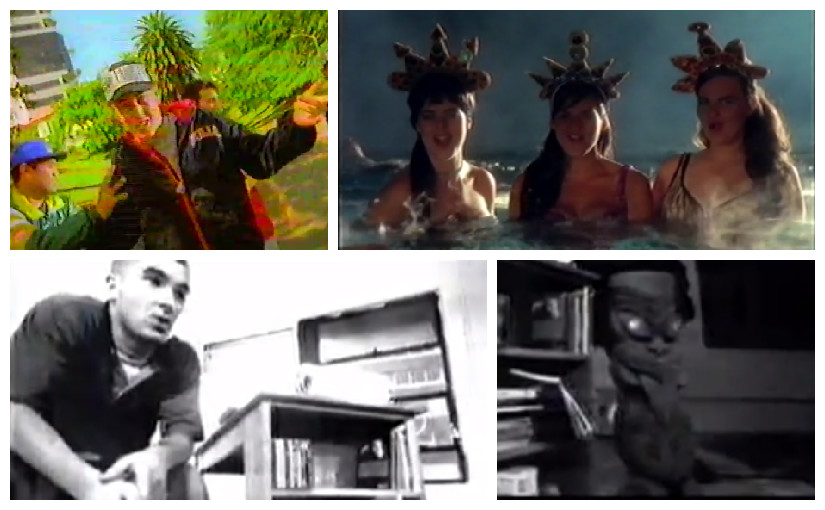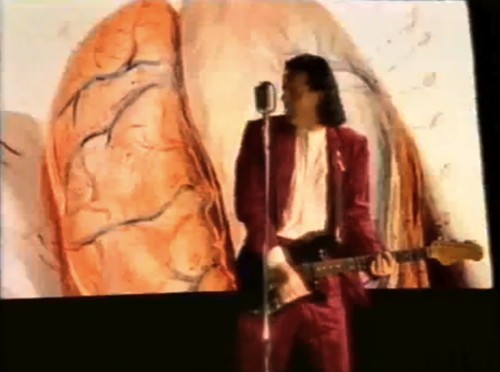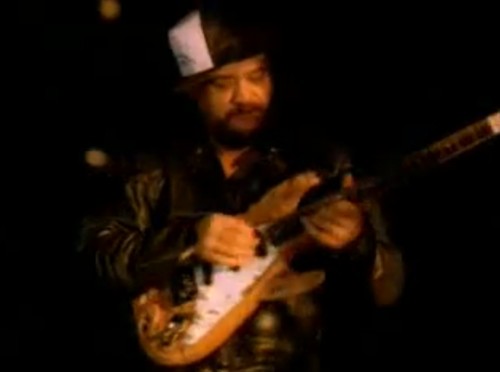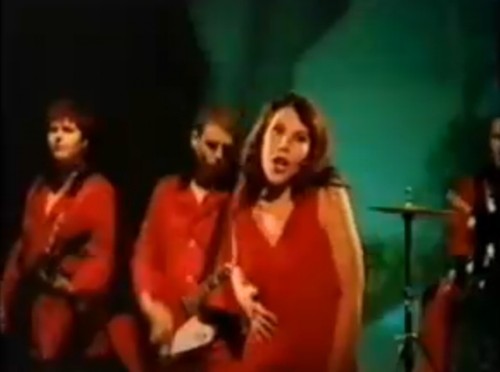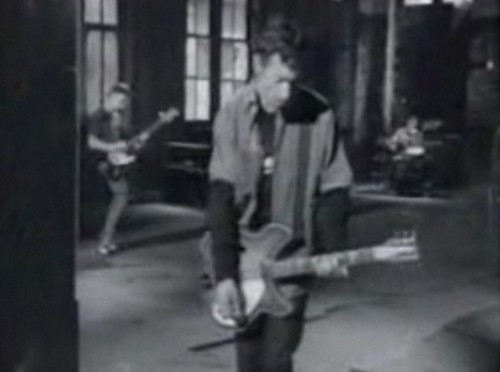Synchronised swimming appears in a music video, there’s a successful attempt at a cool urban scene and a less successful attempt at a gritty urban scene.
Category: April 1994
Alastair Riddell “Peace Dream Solution”
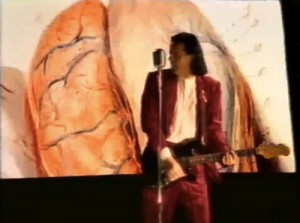 It’s said that when Alastair Riddell and Space Waltz burst onto the scene in 1974 with the Bolan- and Bowie-inspired “Out on the Street” on the New Faces talent show, it was like aliens from planet pop arriving to show the backward earthlings of New Zealand a thing or two. But 20 years later Alastair shows up wondering “whatever happened to the peace dream solution?”
It’s said that when Alastair Riddell and Space Waltz burst onto the scene in 1974 with the Bolan- and Bowie-inspired “Out on the Street” on the New Faces talent show, it was like aliens from planet pop arriving to show the backward earthlings of New Zealand a thing or two. But 20 years later Alastair shows up wondering “whatever happened to the peace dream solution?”
Restlessly sitting in a Le Corbusier chaise longue, he watches a rapidly changing slide show of images of world history and culture from the last two decades. Martin Luther King Jr, starving Africans, Ronald Regan, Pope John Paul II and Elvis flash past, like the reprogramming scene from “A Clockwork Orange”.
But the song comes across less as a lament and more as a dig at the boomer generation, the former flower children who can be now found in the gyms, concerned more about their physique than peace and love.
I found a 2007 TV show where Paul Holmes grills Alastair about the meaning of “Out on the Street”. He answers, “A lot of people were making a lot of noise about the new age, the age of Aquarius. We had “Hair” some years before. And I really thought that the age we lived in was a bit more like a whore or a lady of the night.” So it seems he was never a great believer in the promise of the peace dream solution, but perhaps it come as a shock just how rapidly his generation discarded those ideals.
As the video progresses, Alastair gets off the couch and turns his back on the slideshow, instead rocking out with his guitar. There’s also a bit of animation, involving Elvis stamps and strongmen. Very ’90s.
The video ends with Alastair in a military uniform, singing “all you need is love”. It’s like something out of “Hair” – the hippy is shockingly revealed to be part of the establishment. Whoa.
Best bit: the Regan-faced pope.
Tama Renata “Theme from Once Were Warriors”
 So, how do you sell a song that is the theme tune for a bleak film centred around themes of poverty and violence? The video for the theme from “Once Were Warriors” avoids all the rough bits, but still leaves plenty of menace.
So, how do you sell a song that is the theme tune for a bleak film centred around themes of poverty and violence? The video for the theme from “Once Were Warriors” avoids all the rough bits, but still leaves plenty of menace.
Tama Renata plays his carved guitar, with plenty of whammy-bar action and intricate fingering. This is cut with scenes from the film showing gangs, fierce hakas and simmering tension that’s just going to lead to you-know-what. But there are also happier scenes – Jake filling up his plate with kai, the two gang bros doing the eyebrows, and a nice pash, and the girls sharing a laugh.
So it’s a pretty standard film soundtrack video. But yet while the song and the video don’t explicitly illustrate the violent bits of the film, we all know what’s coming.
Best bit: the eyebrows.
Director: Lee Tamahori
Ngā Taonga Sound & Vision
Purest Form “Message To My Girl”
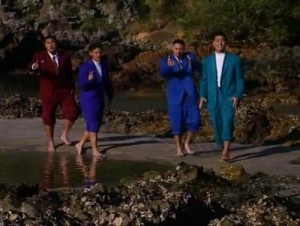 As the cruel hand of history would have it, Purest Form are best known for their barbershop quartet performance in the Rainbow’s End ad.
As the cruel hand of history would have it, Purest Form are best known for their barbershop quartet performance in the Rainbow’s End ad.
But then they weren’t singing the praises of the Motion Master, they were having a go at a proper pop career. Their first single was a sweet cover of Split Enz’s “Message to my Girl”.
Dressed in suits of the ’90s power palate (deep red, teal green, sky blue) the quartet perform the song on a west coast beach. It’s a fine day, with plenty of golden sunshine, but the jagged rocks on the beach don’t quite make it as romantic as perhaps the band intended.
The song is ok, but the arrangement tends to overegg the pudding. “I don’t wanna say I want you,” one singer croons. But that’s not enough. Another comes in with a sensually whispered, “I want you.”
The song has a really ambitious, epic quality to it, complete with a spoken break that starts with “Giiiirl, you know me…” But where were Purest Form when vocal harmony groups like Backstreet Boys and Nsync were tearing up the charts around the turn of the millennium? The Form came too soon.
Best bit: the smooth velvety spoken bit.
Next… a trip to Taumarunui.
Eye TV “Eye TV”
 The song and the band have the same name because the band used to be called the Nixons and took their new name from their album (and song) called Eye TV. I don’t remember the band from this stage. They had quite a different vibe from their later work.
The song and the band have the same name because the band used to be called the Nixons and took their new name from their album (and song) called Eye TV. I don’t remember the band from this stage. They had quite a different vibe from their later work.
For a start, Sean the lead singer had long black hair (goth!), and the drummer was Mark, who I used to work with at dirty old Ihug back in the ’90s. In fact, the whole song has a much gothier tone than their later stuff.
The video takes place in a slightly unusual house, where the band hangs out. A box is opened, emitting a mysterious bright light. The video also introduces the ubiquitous mid-’90s colour palate of forest green, deep red, mustard yellow and sky blue. (I had a duvet with these colours.)
The band end up posing as thugs, before dragging the lead singer away. They then assemble for one final rock-out in the colourful room. Then – lol – the lead singer eats a flower.
Best bit: the smashed house of cards. Yeah, take that.
Next… a smooth boyband.
Mana “Ain’t Gonna Stop”
 It’s a dilemma of music videos – how to film the band performing in front of a (fake) audience when no one wants to give up their weekend pretending to go mental over the same song again and again. Add children into the mix and you’re just asking for trouble.
It’s a dilemma of music videos – how to film the band performing in front of a (fake) audience when no one wants to give up their weekend pretending to go mental over the same song again and again. Add children into the mix and you’re just asking for trouble.
“This is for the choowdrun!” And with that a hoarde of kids burst into the Freemans Bay Community Hall where the band play their latest single. The song starts with some synthesizer strings, hilariously brought to life by getting a teen string quartet (minus one) to “play” the string parts.
The lead singer of Mana is wearing a drive-through mic, which means he can engage in daggy dancing while he sings. The rest of the band look swamped on the large hall stage. Perhaps this is the largest gig they’ve ever done.
It seems like the original idea of this video was to have the band play the song at a concert full of children. But in the big group shot, I can only count about 16 kids plus a few grown-ups. Obviously Mana are not the reggae Wiggles and don’t have the pulling power for that demographic.
The children can be seen dancing along with a slight self-consciousness, and the ones who end up dancing on stage seem to be doing so like a under-rehearsed school production, rather than a spontaneous get-down.
I can’t help think that this song would have been better served by a family fun day at the beach setting.
Best bit: the spotty string section.
Next… eating a flower.
Greg Fleming “Codeine Road”
 Nurofen Plus – it’s my wife and it’s my life. I’m not sure what this song is about. It might be about homebake, or it might be about debilitating lower back pain. All I know is that only Auckland could produce a gritty life-is-tough song based around an over-the-counter analgesic.
Nurofen Plus – it’s my wife and it’s my life. I’m not sure what this song is about. It might be about homebake, or it might be about debilitating lower back pain. All I know is that only Auckland could produce a gritty life-is-tough song based around an over-the-counter analgesic.
Regardless of the dramatic lyrics, the video is still pretty interesting. It’s shot around Karangahape Road when it was still seedy and grimy, a good decade before it started to get gentrified and all the pink bits moved away.
K Road regulars can be seen hanging around, and there’s even a shot of the old McDonald’s before K Road became too cool for a McDo. Another ’90s memory – the mural by the Baptist tabernacle that was all “No one comes to the father except through me”. Cut with this footage, Greg Fleming mooches around the area, sometimes with his bros, other times on his own.
I’m trying to think – was K Road scary and dark back then? Maybe it only felt that way if you were luxuriating in a warm blanket of Panadeine.
Best bit: the wistful looking lady holding an elaborately wrapped gift.
Director: Bruce Sheridan
Ngā Taonga Sound & Vision
Next… for the children.
Grace “Confessions”
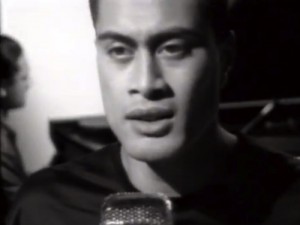 This is the first single for the group based around the three Ioasa brothers, but you know what? The video is better than the song. This is for one simple reason:
This is the first single for the group based around the three Ioasa brothers, but you know what? The video is better than the song. This is for one simple reason: Anthony Jason Ioasa’s fabulous cheekbones. The video, directed by Jonathan King, takes full advantage of this, with dramatic lighting to emphasise his features.
But, ok, it’s not all bone structure. While the video does linger on the singer, the rest of the band can be seen working away in the background, even with wide shots that reveal more of the studio set-up of the video shoot.
It seems like a low-budget video, but one done with skill and technique so it doesn’t look low-budget. As well as the moody lighting, it’s shot in black and white with an olive tint. Pretty stylish for a first video. The Ioasa bros were obviously going to have to raise the stakes for their next.
Best bit: Jason Ioasa’s cheekbones, ok?
Director: Jonathan King
Ngā Taonga Sound & Vision
Next… over-the-counter pain relief.
Crash “Red Velvet”
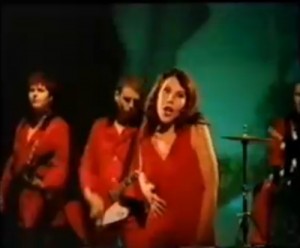 Crash is another mysterious band that managed to show up in the ’90s, release some songs, then vanish without really leaving much of an impact. Yet this video remains as a reminder of what once was.
Crash is another mysterious band that managed to show up in the ’90s, release some songs, then vanish without really leaving much of an impact. Yet this video remains as a reminder of what once was.
“Red Velvet” – which appears to actually be an ode to a couch, or possibly a woman who is like a couch – is a poppy but slightly gothy Britpopesque song. That is, a perfectly respectable ’90s song.
The band’s frontwoman spends the verses lounging on a – wait for it – red velvet sofa, in the style of classical tableaux. In these tableaux, she’s joined by a couple of other women who look like they’d live in the Hutt and do medieval reenactments on the weekend.
When the chorus comes around, the action switches to the band. The drummer is steadily playing along, the guitarist is doing a full-on rock face, and the bassist is nervously jigging about, as if someone’s mum has said, “Come on, you’ve got to look a bit more lively than that!”
Best bit: the wind machine owns the dreamy chorus.
http://youtu.be/mVoC9IC7oKE
Next… fabulous cheekbones.
Bailter Space “X”
 I listened to a lot of Bailter Space in the ’90s, but I don’t remember many of their videos. “X” is a great song in that the vocals are obviously the lowest priority sound behind the guitars and drums. Yeah, Bailter Space were a guitary band; a dude band (though now they’re a cool-dad band).
I listened to a lot of Bailter Space in the ’90s, but I don’t remember many of their videos. “X” is a great song in that the vocals are obviously the lowest priority sound behind the guitars and drums. Yeah, Bailter Space were a guitary band; a dude band (though now they’re a cool-dad band).
The video sees the trio playing their song in an old warehouse, probably in America judging from a “police department” sign proclaiming “no guns beyond this point”. The video is filmed in black and white, with lots of scratchy, grainy layers, as if the film was retrieved from the bottom of the Hudson River, still encrusted with city sludge.
The vid also includes a remnant of the past: a cigarette. As the video begins, Alister casually lights up. This used to happen in music videos. Cigarettes were a visual shorthand for cool. Then parents got angry about the effect that cigarettes in videos would have on their children, and all the ciggies vanished. Now the only smoking you’re likely to see is a blinged-up cigar, if that.
Bailter Space, the smoking gentlemen of New York, get to hold on to that memory.
Best bit: the brief road trip, with doggy-style head out the window.
Director: David Kleiler
Ngā Taonga Sound & Vision
Next… an ode to home decor.
